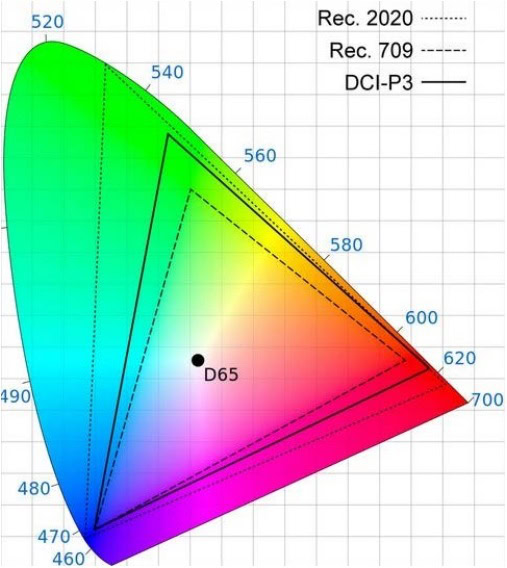DLPA078C February 2017 – October 2024 DLP160AP , DLP160CP , DLP2000 , DLP2010 , DLP230GP , DLP230KP , DLP230NP , DLP3010 , DLP3310 , DLP4710 , DLP471TP , DLPC3420 , DLPC3421
3.3 Color Management
The color gamut of a display system indicates the range of colors the display system produces, defined by the three additive primary colors: red, green, and blue. In an LED-illuminated optical module, the range is determined by the colors of the individual LEDs and filters used in the system. The color gamut is traditionally plotted in the 1931 CIE chromaticity space.
Most optical module projectors conform to one of the following color gamut standards: Rec.709 (also known as BT.709), DCI-P3, and Rec.2020 (also known as BT.2020). Rec.709 is the standard for HDTV, Rec.2020 is the standard for Ultra-high definition (UHD), and DCI-P3 is the standard used in Digital Cinema. While there are significant overlaps among these color gamuts, each defines a distinct area within the visible color spectrum. Notably, the Rec.2020 color gamut covers the largest portion of the visible color spectrum, encompassing both Rec.709 and DCI-P3 (see Figure 3-1).
DLP Display projection optical modules produces variable white points and color temperatures. Each optical module is adjusted by the optical module manufacturer and programmed in various modes (such as cool, normal, warm) in the final product. (1).
For more information regarding color management in an optical system, refer to slides 77 - 83 of the DLP Optical Design Guidelines presentation.
The brightness specification of an optical module varies depending on the white point. If color accuracy is a key requirement for the final product, specifying a target white point, such as Illuminant D65, is recommended
 Figure 3-1 Color Gamut
Figure 3-1 Color Gamut